Nigeria is home to a wide variety of beautiful and interesting birds. From the colorful parrots of the rainforest to the majestic birds of prey of the savannah, Nigeria’s birdlife is a feast for the eyes and ears.
The country is also home to approximately 583 species of birds, ranging from the tiny Sunbird to the impressive Hammerkop, making it a paradise for birdwatchers.
In addition to its vibrant avifauna, Nigeria is also home to a number of important bird sanctuaries where conservation efforts are underway to protect the country’s birds and their habitats.
With so much to explore and learn about Nigeria’s birds, it’s no wonder that it’s a popular destination for birders from all over the world.
1. Hamerkop
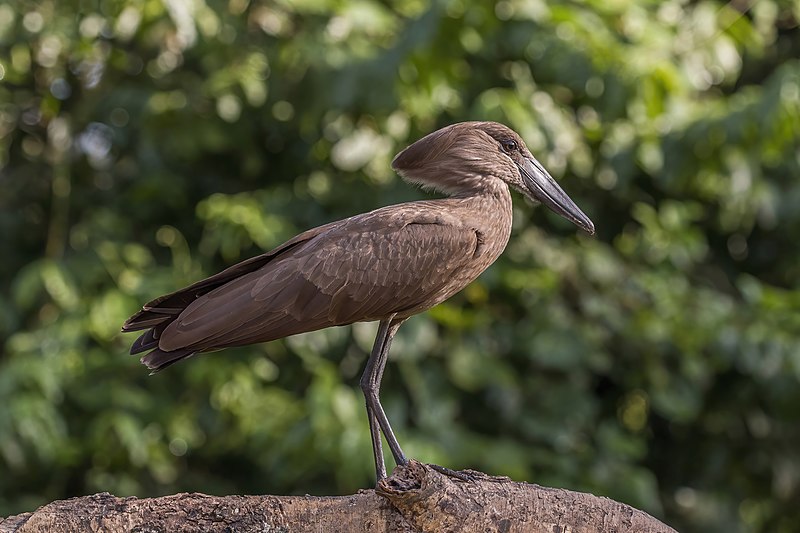
The Hamerkop is a unique wading bird found across sub-Saharan Africa and as far east as India.
It has an unmistakable silhouette, with its long bill topped by a crest at the back of its head that gives it the look of a hammerhead shark.
Its plumage consists mainly of browns and greys, providing excellent camouflage in reed beds.
The species was once classified alongside storks but is now believed to be closely related to pelicans and shoebills instead.
This medium-sized bird feeds on insects, fish, frogs or small reptiles which it captures from shallow water or plucks from trees near bodies of water.
Despite being considered ‘unlucky’ by some cultures due to superstition surrounding their appearance they are actually quite important for controlling populations of certain pests.
Scientific classification:
| Kingdom | Animalia |
| Phylum | Chordata |
| Class | Aves |
| Order | Pelecaniformes |
| Family | Scopidae |
| Genus | Scopus |
| Species | S. umbretta |
Also Featured In: Chad Birds You Didn’t Know, African Birds
2. Turaco
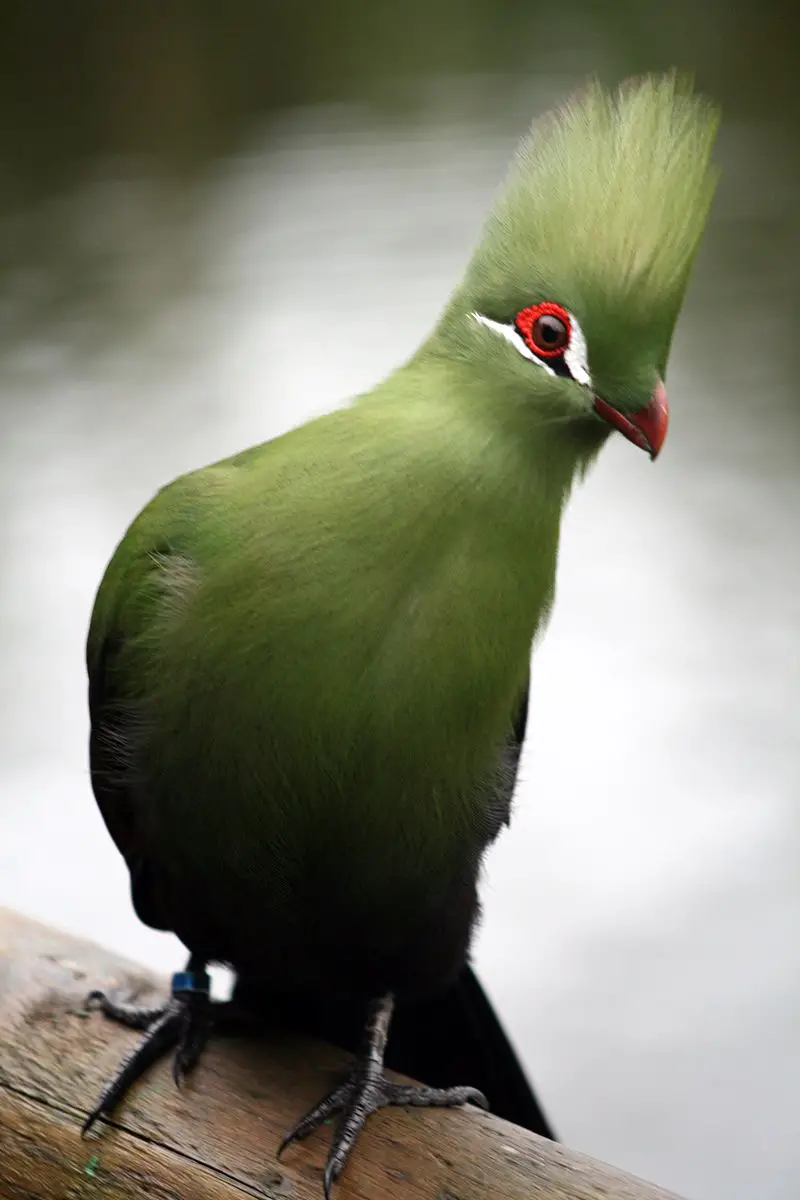
Turacos are a unique bird family that inhabit tropical and subtropical regions of Africa. They are also known as “banana-eaters” or “loeries” in southern Africa, due to their diet which consists mostly of fruit such as plantains.
These birds have an interesting semi-zygodactylous foot structure – the fourth toe can be switched back and forth while the second and third toes remain conjoined.
Turacos come in different sizes depending on species but they all generally boast bright colors like green, blue, purple or red feathers with vibrant yellow eyes.
In addition to being beautiful creatures, these birds make loud calls during mating season which makes them even more special.
Scientific classification:
| Kingdom | Animalia |
| Phylum | Chordata |
| Class | Aves |
| Clade | Otidimorphae |
| Order | Musophagiformes Seebohm, 1890 |
| Family | Musophagidae Lesson, 1828 |
Also Featured In: Native Birds of Equatorial Guinea, Common Tropical Rainforest Birds
3. Bee-Eater
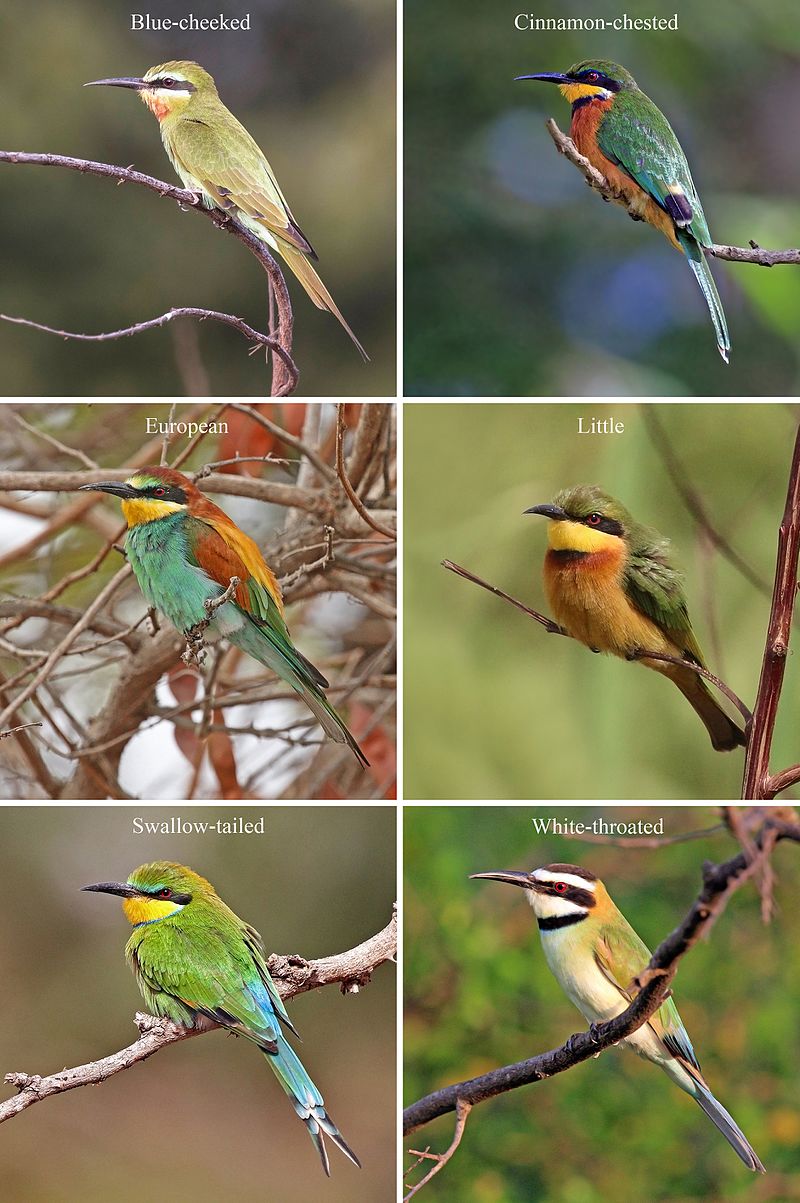
Bee-eaters are one of the most beautiful and vibrant birds in existence. They have a slender body, long wings, down turned bills and their signature elongated central tail feathers which make them instantly recognizable from afar.
Their plumage is incredibly colorful with many shades ranging from blues to greens to reds that glisten when they fly through the air.
These stunning creatures can be found all over Africa, Asia, Southern Europe, Australia and New Guinea where they feed mainly on bees but also other insects like flies or wasps as well as small mammals such as lizards or rodents.
Bee-eaters live in colonies near rivers or wetlands so that they may easily hunt for food while staying close together for safety purposes.
Additionally it allows them to better display their impressive courtship dances during mating season.
Scientific classification:
| Kingdom | Animalia |
| Phylum | Chordata |
| Class | Aves |
| Order | Coraciiformes |
| Family | Meropidae Rafinesque, 1815 |
Also Featured In: Turkey Birds You Should Know, Common Algerian Birds
4. Anambra Waxbill
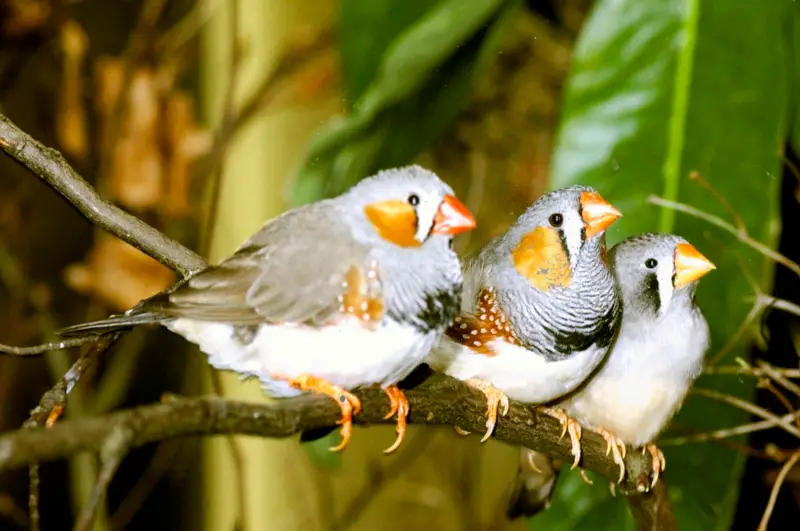
The Anambra waxbill is a species of estrildid finch native to wetter land in southern Nigeria and Benin. It has a global range covering an area of 38,000 km2 and measures around 12 cm long.
Its plumage is mostly dun-coloured with fine barring on its upperparts, sides of breast, and flanks. The bill and rump have reddish brown hues that add to the bird’s beauty.
This small but beautiful songbird enjoys eating insects as well as grass seeds which are usually found near waterways or swamps.
They form monogamous pairs for breeding purposes during which time they produce typical nest cup made from plant material held together by spider webs or cobwebs at the base of trees or shrubs close to water bodies like riversides or lakeshores.
As such conservation efforts should be taken up ensure their continued survival so we can continue enjoying this avian marvel.
Scientific classification:
| Kingdom | Animalia |
| Phylum | Chordata |
| Class | Aves |
| Order | Passeriformes |
| Family | Estrildidae |
| Genus | Estrilda |
| Species | E. poliopareia |
5. Ibadan Malimbe
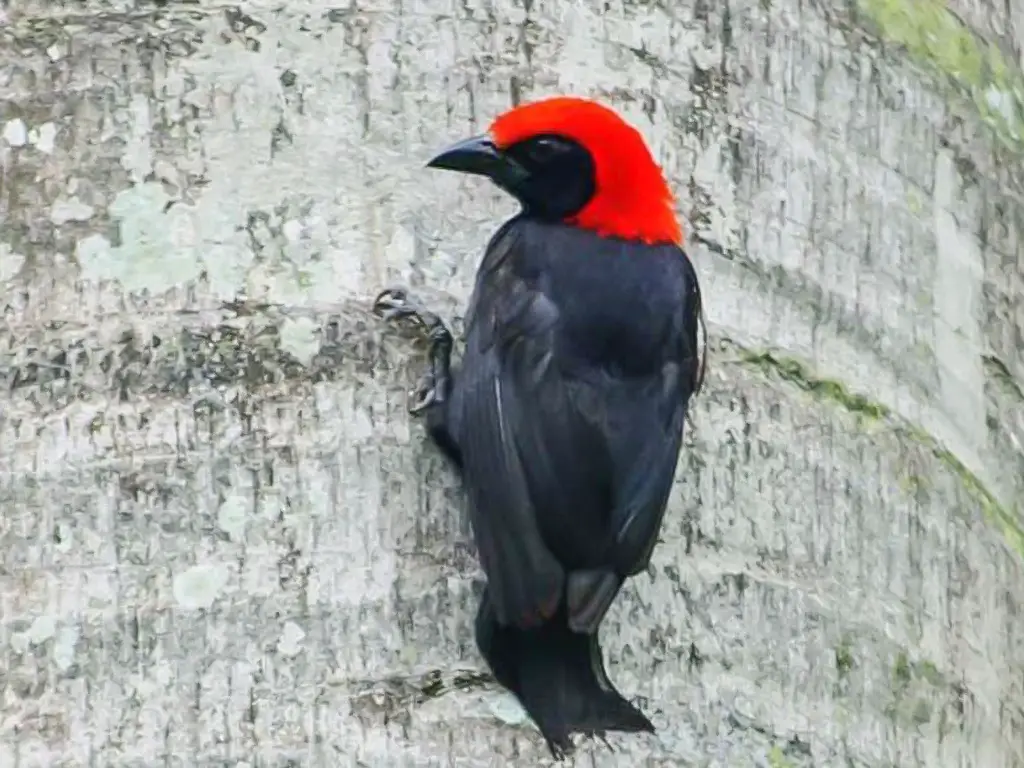
The Ibadan malimbe is a rare species of bird found only in the southwestern part of Nigeria. It was first discovered in 1951 and named after the city of Ibadan, where it was quite common at one time.
Unfortunately, due to extensive forest clearing its numbers have dwindled significantly over the years making it an endangered species.
It measures roughly 20 centimeters long and has striking black plumage on its body with some yellow features around the head area.
Although this beautiful creature is considered to be vulnerable now, conservation efforts are being made to protect them from further harm caused by habitat destruction or other human activities like poaching etc.
Scientific classification:
| Kingdom | Animalia |
| Phylum | Chordata |
| Class | Aves |
| Order | Passeriformes |
| Family | Ploceidae |
| Genus | Malimbus |
| Species | M. ibadanensis |
6. Woodland Kingfisher
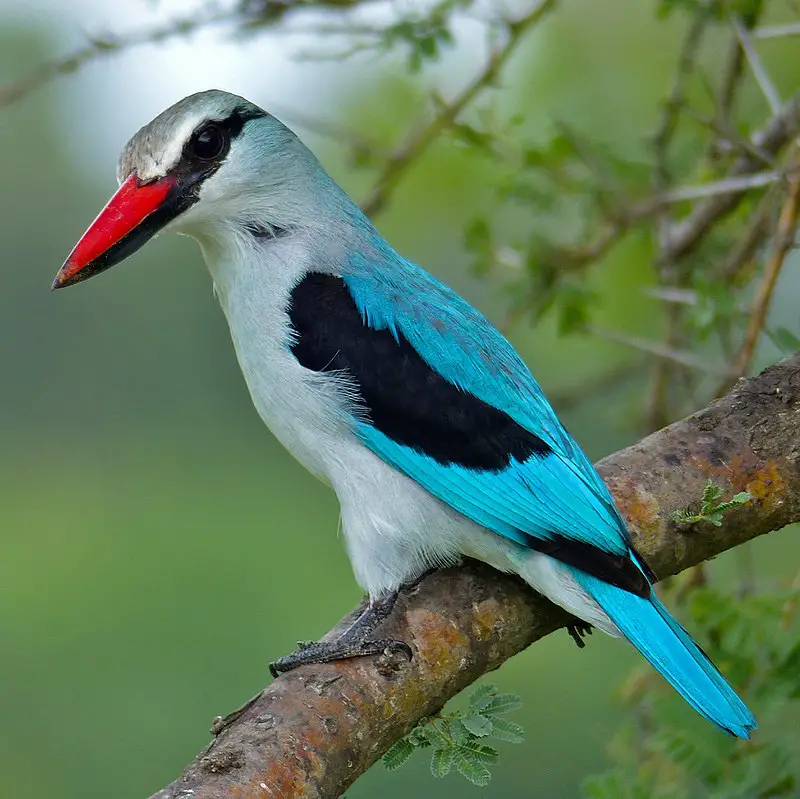
The Woodland Kingfisher is a beautiful bird, native to Africa south of the Sahara. It was first described in 1766 by Carl Linnaeus who called it Alcedo senegalensis.
This tree kingfisher has an attractive blue and white plumage with some red and black markings on its wings, tail and head.
The male also has a bright orange beak which helps to distinguish him from the female whose beak is yellowish-green.
These birds can usually be found in wooded areas near water sources such as rivers or lakes where they hunt for food including fish, frogs, small insects and even lizards.
They build their nests either high up in trees or inside holes dug out of banks near rivers and ponds.
Although not threatened yet, these lovely creatures need our protection so that future generations will have the chance to marvel at them too.
Scientific classification:
| Kingdom | Animalia |
| Phylum | Chordata |
| Class | Aves |
| Order | Coraciiformes |
| Family | Alcedinidae |
| Subfamily | Halcyoninae |
| Genus | Halcyon |
| Species | H. senegalensis |
Also Featured In: Birds that Live in Benin, Birds You’ll Find in Kenya Safari
7. Abyssinian Roller
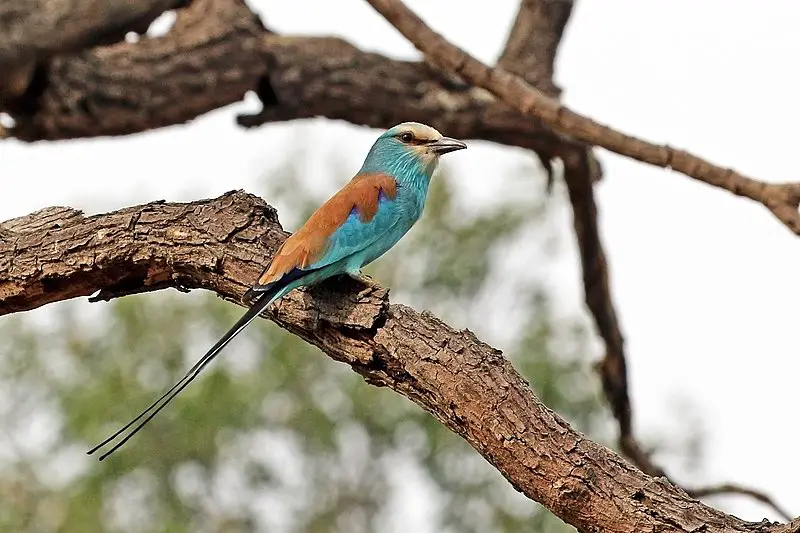
The Abyssinian roller is a large bird, nearly 28 cm in length. It has an unmistakable plumage of bright blue upperparts with chestnut underparts and wings.
Its head is blackish-blue and its tail feathers are white tipped giving it a striking appearance when seen in flight.
This species breeds across tropical Africa from the Sahel belt south of the Sahara desert to East Africa.
Northern populations tend to migrate short distances after wet season while southern ones stay resident throughout year.
They feed mainly on insects which they catch by hovering over fields or open woodland before diving down onto their prey below them.
In addition, they also eat small reptiles, amphibians and rodents along with fruits such as figs occasionally too.
Scientific classification:
| Kingdom | Animalia |
| Phylum | Chordata |
| Class | Aves |
| Order | Coraciiformes |
| Family | Coraciidae |
| Genus | Coracias |
| Species | C. abyssinicus |
8. African Grey Hornbill
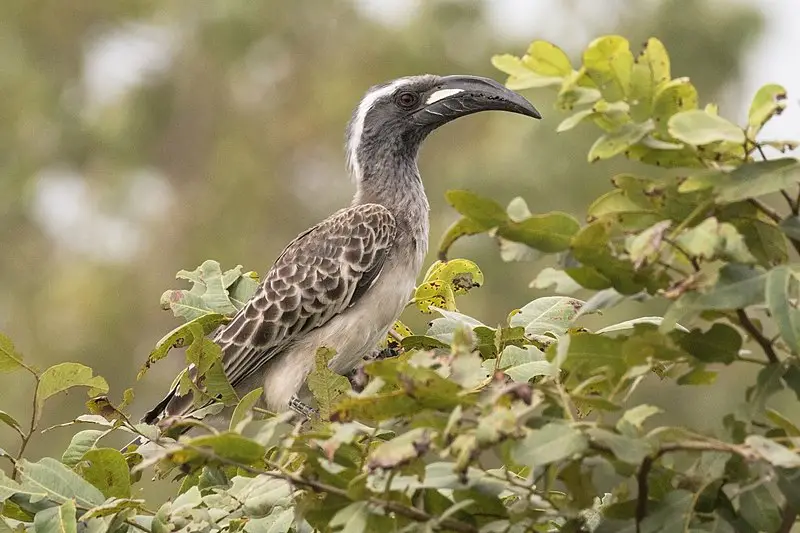
The African grey hornbill is a large bird with striking black and white plumage. Its most recognizable feature is its long, down-curved bill which has a red base and yellow tip.
They are found in sub-Saharan Africa as well as Arabia and have been known to escape or be released into Florida where they may not be breeding yet.
Their diet mainly consists of fruits, insects, small reptiles and amphibians making them important seed dispersers for their habitats.
Hornbills play an important role in the ecosystem by controlling pests like locusts while also providing food for predators such as eagles or larger cats.
These birds are often kept as pets but can become very demanding due to their intelligence so potential owners should do research before considering one of these amazing creatures.
Scientific classification:
| Kingdom | Animalia |
| Phylum | Chordata |
| Class | Aves |
| Order | Bucerotiformes |
| Family | Bucerotidae |
| Genus | Lophoceros |
| Species | L. nasutus |
Also Featured In: Birds that You’ll Find in Kruger national park, Birds of Etosha National Park
9. Red-Throated Bee-Eater
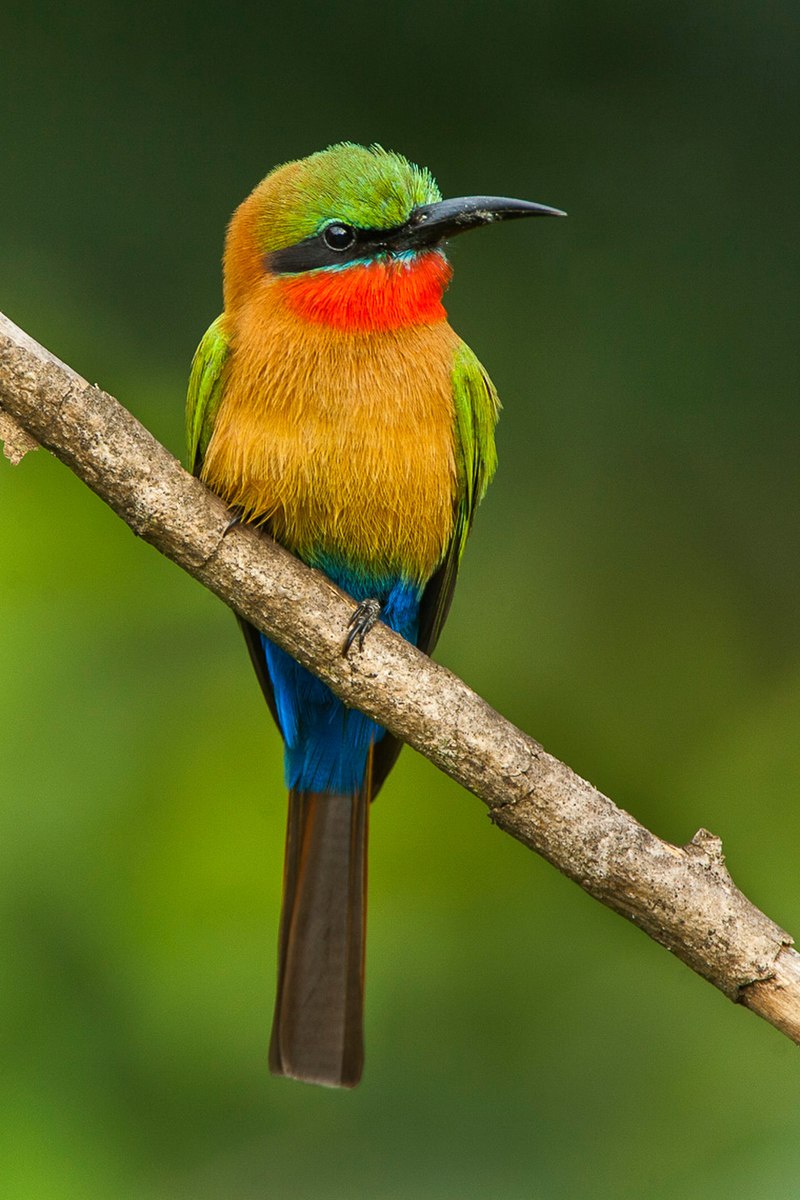
The Red-throated Bee-eater is a beautiful species of bird found in tropical Africa. It has bright red feathers covering its throat, giving it a distinct look.
Its body is mostly brown with white stripes and its wings are dark blue on the tips.
This species enjoys an extensive range throughout countries like Benin, Burkina Faso, and Togo to name just a few.
These birds feed mainly on insects that they catch in midair or from nearby foliage during their hunting flights over open country habitats such as woodlands and savannas.
While not much else is known about this particular type of bee-eater, these colorful creatures have surely become quite popular due to their striking beauty.
Scientific classification:
| Kingdom | Animalia |
| Phylum | Chordata |
| Class | Aves |
| Order | Coraciiformes |
| Family | Meropidae |
| Genus | Merops |
| Species | M. bulocki |
Also Featured In: Birds of Côte d’Ivoire,
10. Rock Firefinch
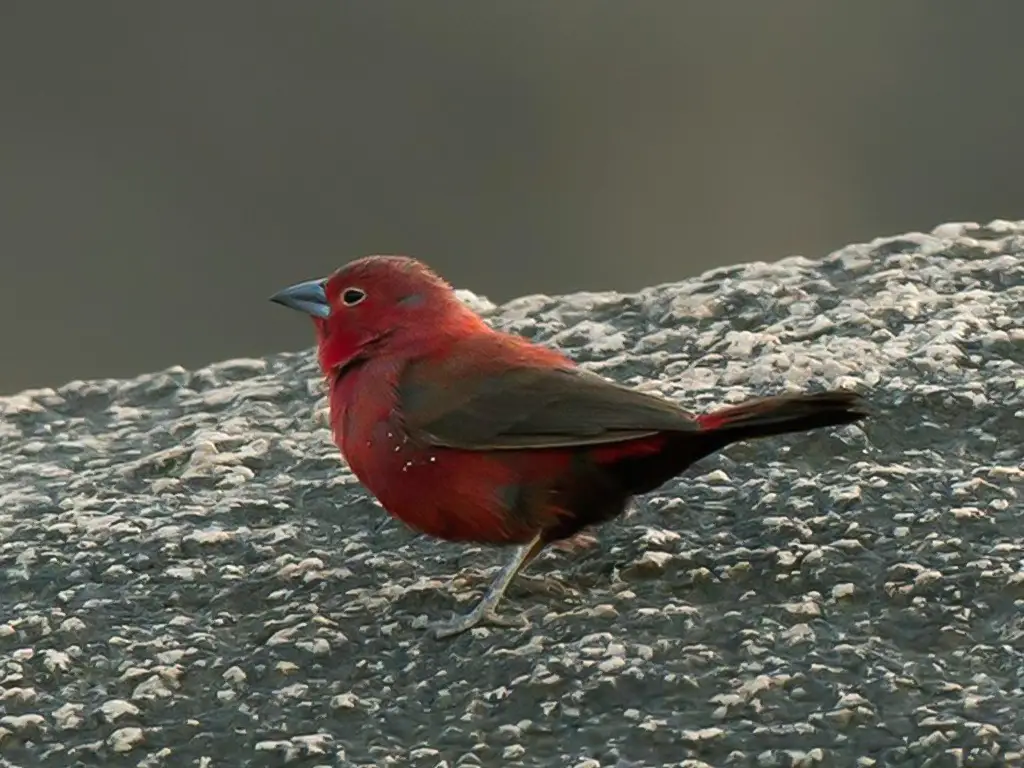
The Rock firefinch is a species of estrildid finch native to central Nigeria and Cameroon. It was discovered in 1998, with an estimated global extent of occurrence spanning 29,000 km2.
The bird belongs to the family Estrildidae which includes small passerine birds from the Old World and Australasia.
These beautiful creatures have grayish-black upper parts complemented by chestnut wings and tail feathers while their underparts are pinkish or white in coloration.
They feed on seeds as well as insects like grasshoppers and crickets found near rocks or bushes where they often stay concealed during mating season.
Despite being recently discovered, these delightful little birds continue to attract attention for their unique plumage features.
Scientific classification:
| Kingdom | Animalia |
| Phylum | Chordata |
| Class | Aves |
| Order | Passeriformes |
| Family | Estrildidae |
| Genus | Lagonosticta |
| Species | L. sanguinodorsalis |
11. Northern Red-Billed Hornbill
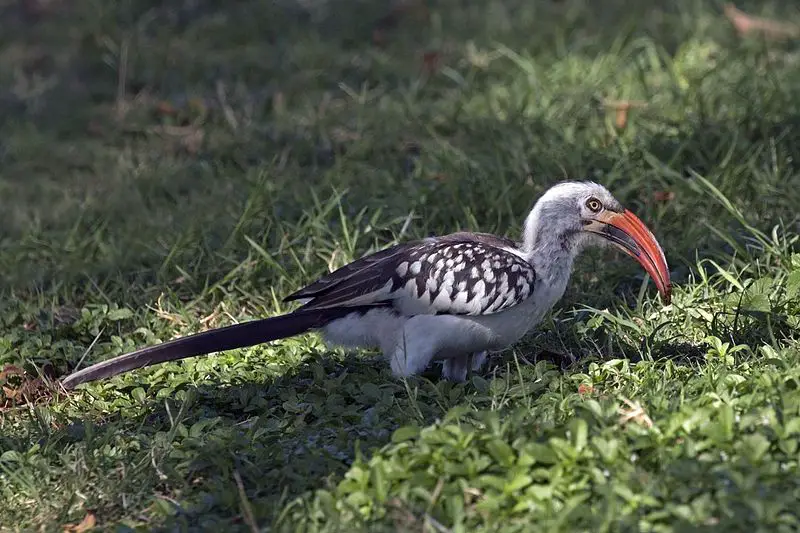
The Northern Red-billed Hornbill is a species of bird belonging to the Bucerotidae family. It can be found in many countries across Africa, from Mauritania through Somalia and Northeast Tanzania.
This hornbill has five recognized subspecies, though all were once considered part of one single species. The northern red-billed hornbill have distinctive black feathers on their body with deep yellow around its eyes and crest.
Its bill and legs are bright red while they feature an impressive casque at the top of it’s head that helps amplify calls during mating season or as a signifier for territoriality towards other birds.
They feed mainly on fruits such as figs but also enjoy insects like moths or beetles when available.
Scientific classification:
| Kingdom | Animalia |
| Phylum | Chordata |
| Class | Aves |
| Order | Bucerotiformes |
| Family | Bucerotidae |
| Genus | Tockus |
| Species | T. erythrorhynchus |
Also Featured In: Savanna Birds You Need to See,
12. Double-Spurred Spurfowl
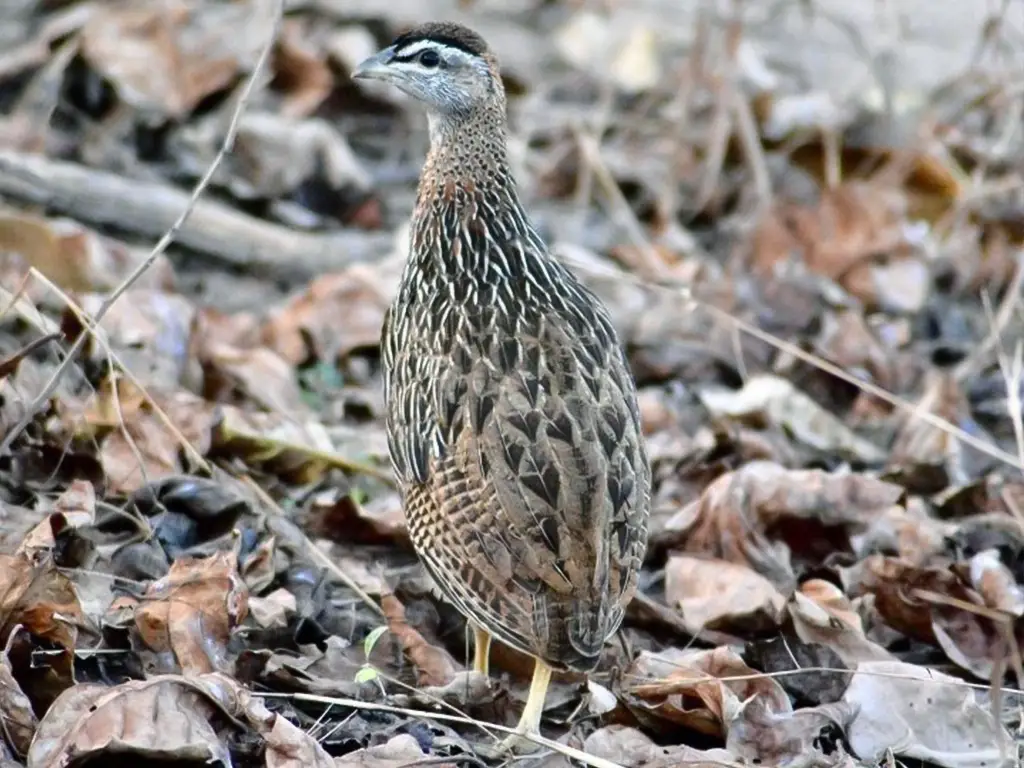
The Double-spurred Spurfowl is a gamebird of the Phasianidae family and belongs to the order Galliformes. It can be found in tropical West Africa, as well as an isolated population in Morocco which is decreasing due to human activity.
In 1760 Mathurin Jacques Brisson described it for the first time with its distinctive double spurs on each leg used during mating displays.
The bird has overall brown coloration but features black stripes along its sides and chest, while having white spots scattered across feathers too.
Its legs are long and thick enabling them to run quickly when escaping predators or searching for food such as insects, seeds or fruits that make up their diet.
These birds form monogamous pairs who defend territories fiercely against intruders all year round whether other spurfowls or humans encroaching into their habitats directly threatening conservation efforts being made by organisations around the world today.
Scientific classification:
| Kingdom | Animalia |
| Phylum | Chordata |
| Class | Aves |
| Order | Galliformes |
| Family | Phasianidae |
| Genus | Pternistis |
| Species | P. bicalcaratus |
13. Blue-Breasted Kingfisher
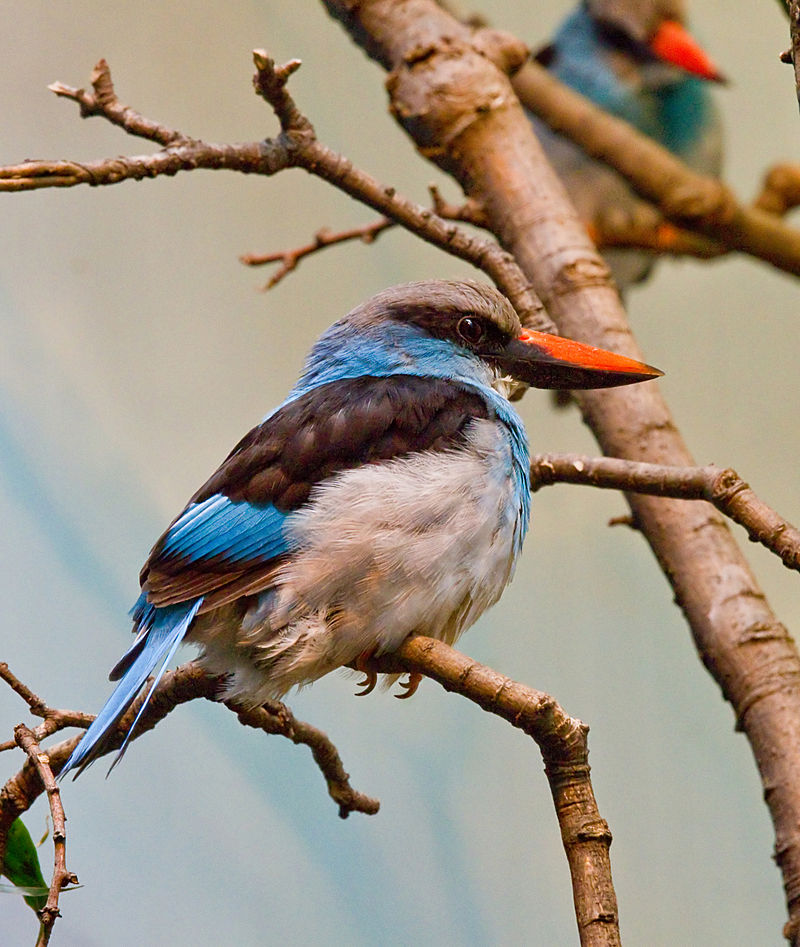
The Blue-breasted Kingfisher is a striking species of bird native to Equatorial Africa. Measuring 25 cm in length, this tree kingfisher has bright blue feathers on its head, back, wings and tail.
Its underparts are white with a contrasting blue breast band for added visual interest.
Though essentially resident there, it does migrate from drier savannas to wetter habitats during the dry season in order to survive better.
This species feeds mainly on insects such as beetles and grasshoppers but will also take small fish when available near the shorelines or riverside vegetation they inhabit.
The beautiful song of these birds can often be heard echoing through their natural environment – an unmistakable sound that makes them easily recognizable.
Scientific classification:
| Kingdom | Animalia |
| Phylum | Chordata |
| Class | Aves |
| Order | Coraciiformes |
| Family | Alcedinidae |
| Subfamily | Halcyoninae |
| Genus | Halcyon |
| Species | H. malimbica |
14. Shining Drongo
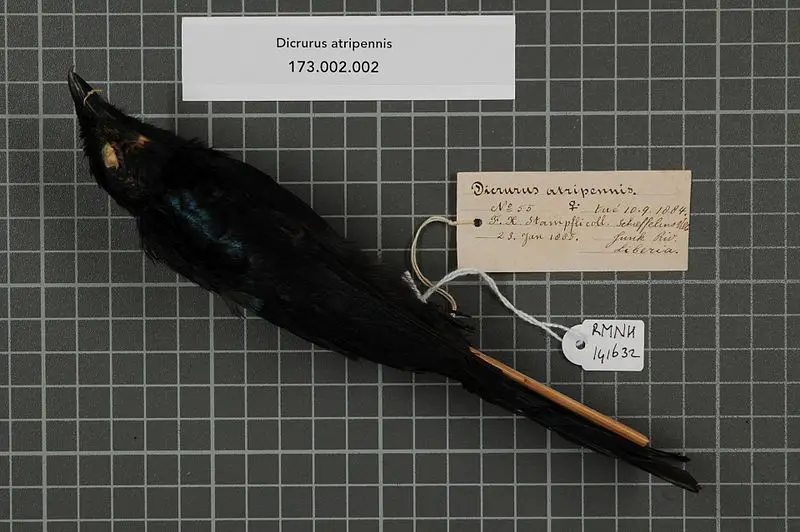
The Shining Drongo is a species of bird in the family Dicruridae, found across several Central and West African countries. It has an unmistakable appearance with black feathers contrasted against bright red eyes and white patches near its tail.
This beautiful creature can typically be seen inhabiting tropical moist lowland forests or woodlands where it forages for food such as insects, fruits and small vertebrates like lizards.
The Shining Drongo also makes distinctive calls which are used to communicate between individuals within their group or even attract mates during mating season.
All in all, this magnificent bird adds diversity to our natural world making it a special sight for any nature lover.
Scientific classification:
| Kingdom | Animalia |
| Phylum | Chordata |
| Class | Aves |
| Order | Passeriformes |
| Family | Dicruridae |
| Genus | Dicrurus |
| Species | D. atripennis |
15. Northern Puffback
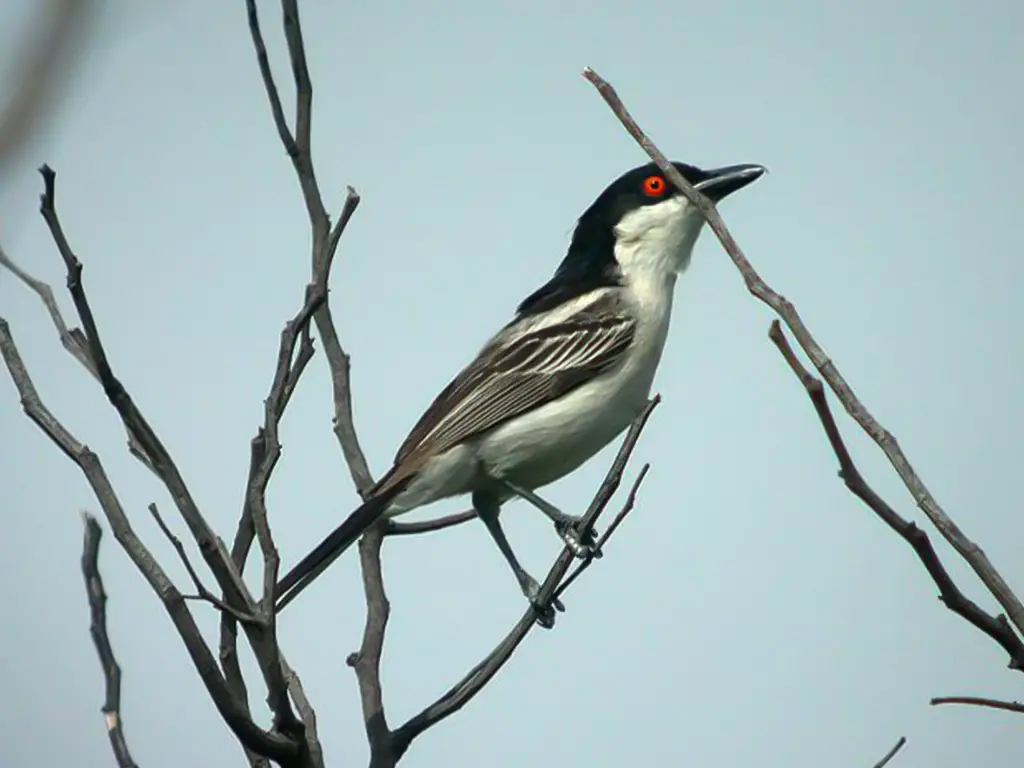
The Northern puffback is a species of bird in the Malaconotidae family. It is found mainly in northern sub-Saharan Africa, and forms a superspecies with its counterpart from eastern equatorial and southern Africa.
These birds are usually found inhabiting subtropical or tropical moist lowland forests, mangrove forests, or even wet savannas. They have distinctive black heads along with white patches on their wings that create an impressive visual display when they fly.
Northern puffbacks feed mostly on insects but also consume fruits for extra energy during migration season which begins at the end of summer each year.
Their conservation status has not been assessed yet by any international organization however local initiatives are being taken to ensure these beautiful creatures continue to thrive in this part of the world for many years to come.
Scientific classification:
| Kingdom | Animalia |
| Phylum | Chordata |
| Class | Aves |
| Order | Passeriformes |
| Family | Malaconotidae |
| Genus | Dryoscopus |
| Species | D. gambensis |
16. African Grey Woodpecker
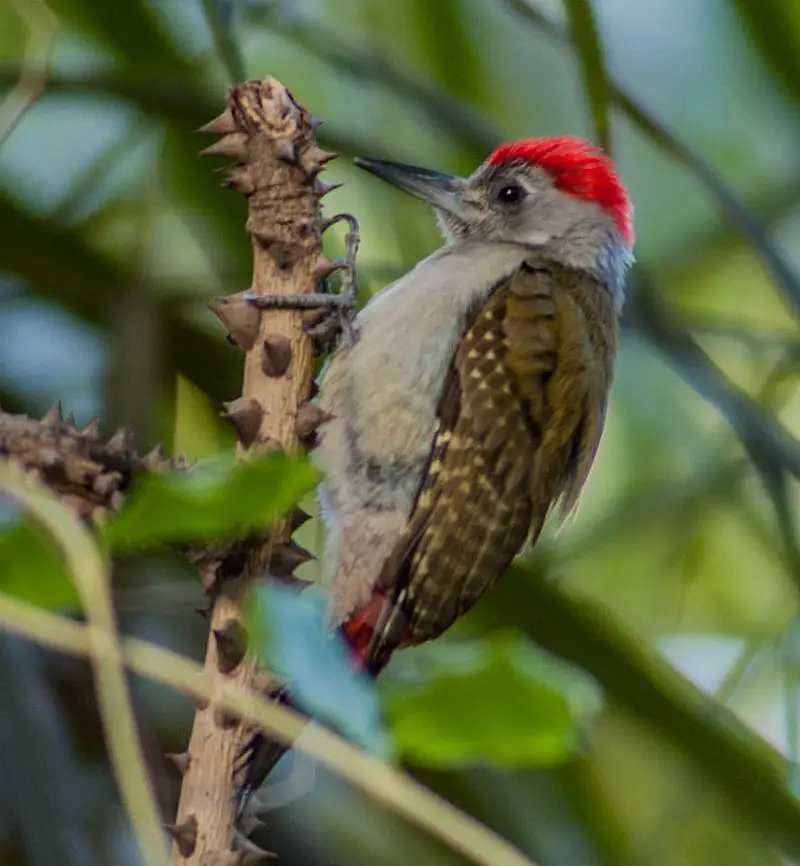
The African Grey Woodpecker is a species of bird found in Sub-Saharan and Equatorial Africa. This bird resides mainly in forest and bush habitats, building its nest inside tree holes using oil palm material to lay two to four eggs.
It’s a common species with an extensive range that stretches across the continent, making it of Least Concern according to the International Union for Conservation of Nature (IUCN).
This woodpecker feeds largely on insects like ants, termites and beetles which are excavated from dead or decaying trees by drilling into them with their beaks.
They can also feed on fruits when they become available during certain times of year.
The African Grey Woodpecker is known as one of Africa’s most beautiful birds due to its stunning gray plumage featuring white scalloping along its back and wings contrasted against black tail feathers.
Scientific classification:
| Kingdom | Animalia |
| Phylum | Chordata |
| Class | Aves |
| Order | Piciformes |
| Family | Picidae |
| Genus | Dendropicos |
| Species | D. goertae |
17. Long-Tailed Nightjar
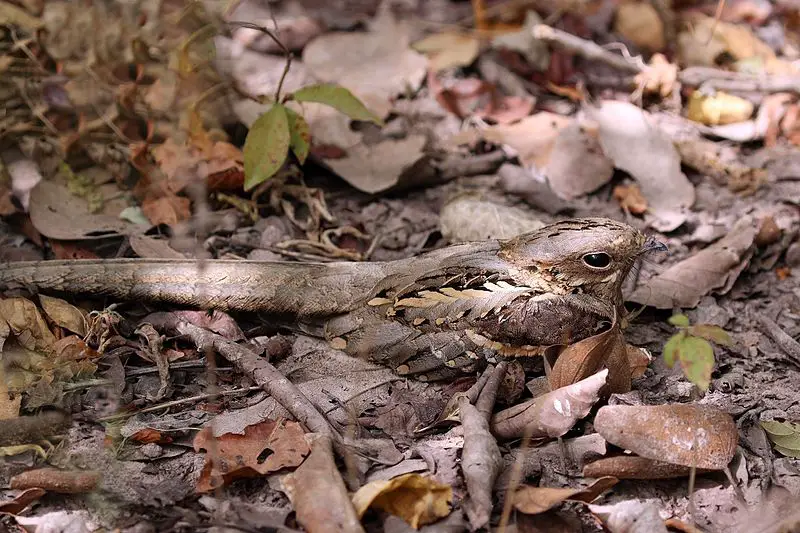
The Long-tailed Nightjar is a small bird native to multiple African countries. It belongs to the family of Caprimulgidae, and has large eyes which allows it to be active at night.
In addition, its wingspan can reach up to 25cm in length – making it one of the larger species within this group.
Its plumage consists mainly of greyish brown with darker markings on both upperparts and underparts; males also have white patches near their tail feathers for added camouflage during flight.
The long-tailed nightjar’s diet consists mostly of insects such as moths, dragonflies and beetles that they hunt from dusk until dawn by swooping down upon them before catching them midair or sipping nectar from flowers.
This nocturnal bird usually roosts in trees during day time but will sometimes use man made structures like telephone poles or buildings as well.
Scientific classification:
| Kingdom | Animalia |
| Phylum | Chordata |
| Class | Aves |
| Order | Caprimulgiformes |
| Family | Caprimulgidae |
| Genus | Caprimulgus |
| Species | C. climacurus |
18. Olive-Bellied Sunbird
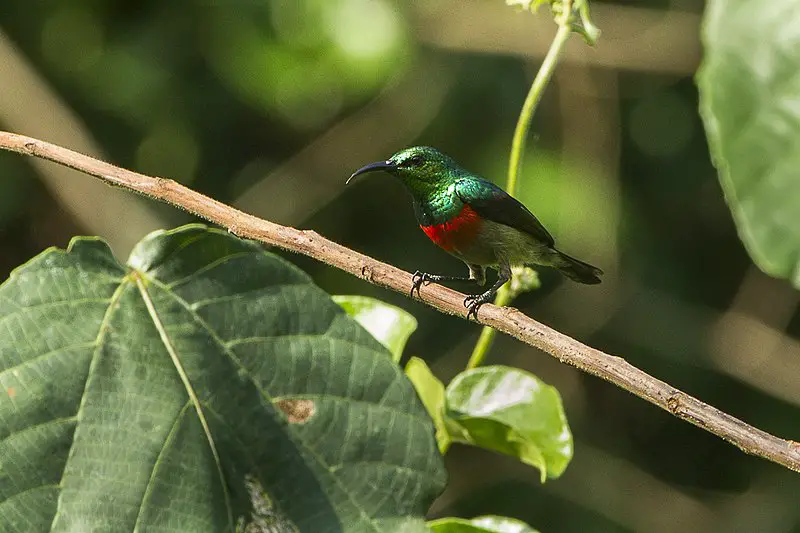
The Olive-bellied Sunbird is a captivating species found in African tropical rainforest. It belongs to the Nectariniidae family, and has a very similar appearance to the Tiny sunbird.
The adult male boasts an impressive array of colors – its head, back and throat are metallic green while its wings are dark brown, rump is metallic blue and tail black with purple tips.
These birds feed on nectar by hovering around flowers like hummingbirds do. They also eat insects as part of their diet for extra nutrition. Their small size makes them vulnerable to predators.
Thus they often fly close together in large flocks for safety from larger animals such as eagles or snakes which may hunt them down easily because of their lack of defense mechanisms compared to other bird species.
Scientific classification:
| Kingdom | Animalia |
| Phylum | Chordata |
| Class | Aves |
| Order | Passeriformes |
| Family | Nectariniidae |
| Genus | Cinnyris |
| Species | C. chloropygius |
19. Bat Hawk
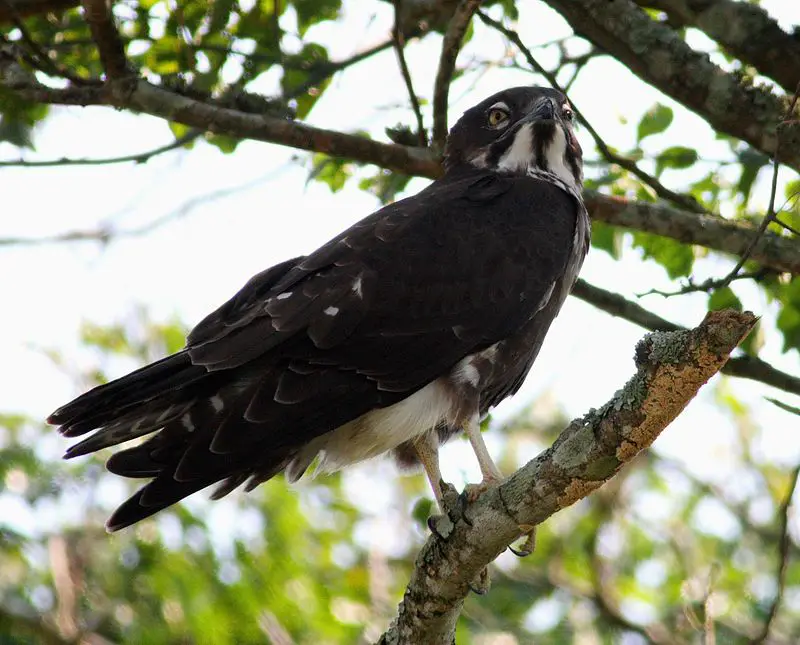
The Bat Hawk is a raptor found across sub-Saharan Africa, south Asia and New Guinea. It has an impressive wingspan of around 45 cm and a slim, falcon-like silhouette.
Its diet mainly consists of bats, which it hunts in open spaces such as rainforests or semi-arid velds. This bird can fly quickly to catch its prey while using its excellent eyesight to spot potential meals from far away.
When hunting bats, the bat hawk swoops down on them swiftly with surprising agility for its size before catching them midair with sharp talons.
The bat hawk is also highly adaptable; being able to thrive under different climatic conditions depending on where it lives – another testament to its amazing abilities.
Scientific classification:
| Kingdom | Animalia |
| Phylum | Chordata |
| Class | Aves |
| Order | Accipitriformes |
| Family | Accipitridae |
| Genus | Macheiramphus Bonaparte, 1850 |
| Species | M. alcinus |
20. Latham’s Francolin
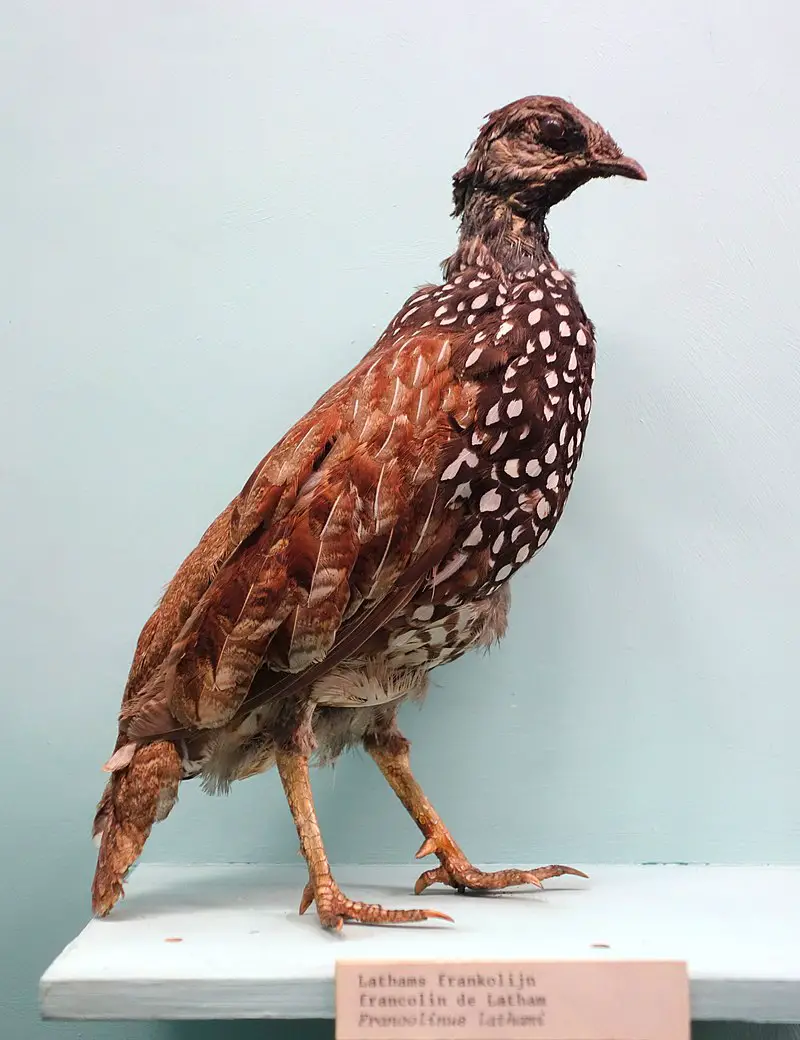
Latham’s francolin is a species of bird found in the family Phasianidae, and it is the only member of its monotypic genus. It can be located throughout Angola, Cameroon, Central African Republic, Congo and many other countries in western Africa.
The birds have distinct black feathers with white tips on their tail as well as chestnut-colored patches near their wings. They also possess a brownish crown that extends to their neck area when they are mature adults.
Latham’s francolins live mainly within forest habitats but can occasionally be spotted amongst grasslands or savannahs for food resources such as seeds and insects which make up part of their diet regimen.
They usually travel alone or in pairs so it isn’t uncommon to spot them searching for food by themselves at times during the day or night.
Scientific classification:
| Kingdom | Animalia |
| Phylum | Chordata |
| Class | Aves |
| Order | Galliformes |
| Family | Phasianidae |
| Tribe | Gallini |
| Genus | Peliperdix Bonaparte, 1856 |
| Species | P. lathami |
21. Shining-Blue Kingfisher
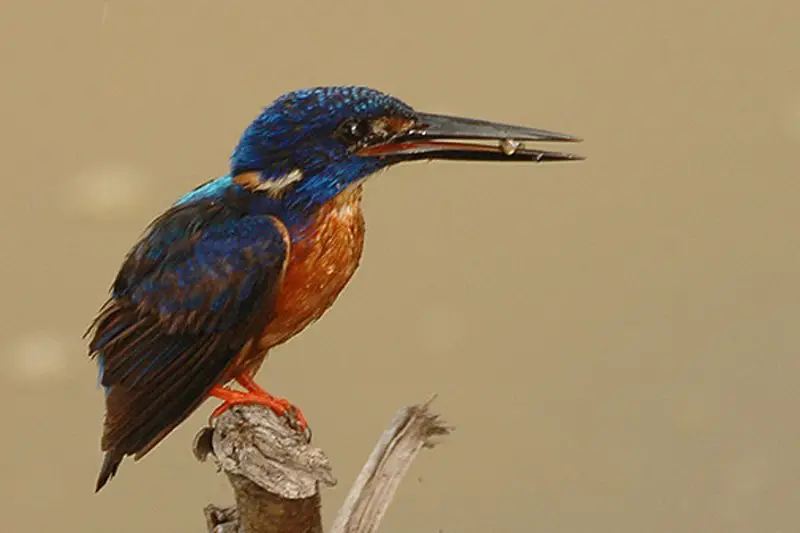
The Shining-blue Kingfisher is a species of bird belonging to the family Alcedinidae that can be found in Equatorial Africa. It was described by French ornithologist Charles Lucian Bonaparte in 1850, who gave it its current binomial name “Alcedo quadribrachys”.
The genus name for this kingfisher comes from Latin, meaning “kingfisher” and the specific epithet derives from two Greek words: “tetra” (four) and “brachus” (armed), referring to its four wings.
This brightly coloured little bird has an iridescent blue head with white spots on either side, along with bright greenish yellow underparts.
Its back is greyish brown while its bill and legs are dark black or slate colouring. These avians feed mostly on small aquatic animals such as insects, crustaceans, molluscs and occasionally small fish they catch near water surfaces using their sharp bills.
Scientific classification:
| Kingdom | Animalia |
| Phylum | Chordata |
| Class | Aves |
| Order | Coraciiformes |
| Family | Alcedinidae |
| Subfamily | Alcedininae |
| Genus | Alcedo |
| Species | A. quadribrachys |
22. Black Bee-Eater
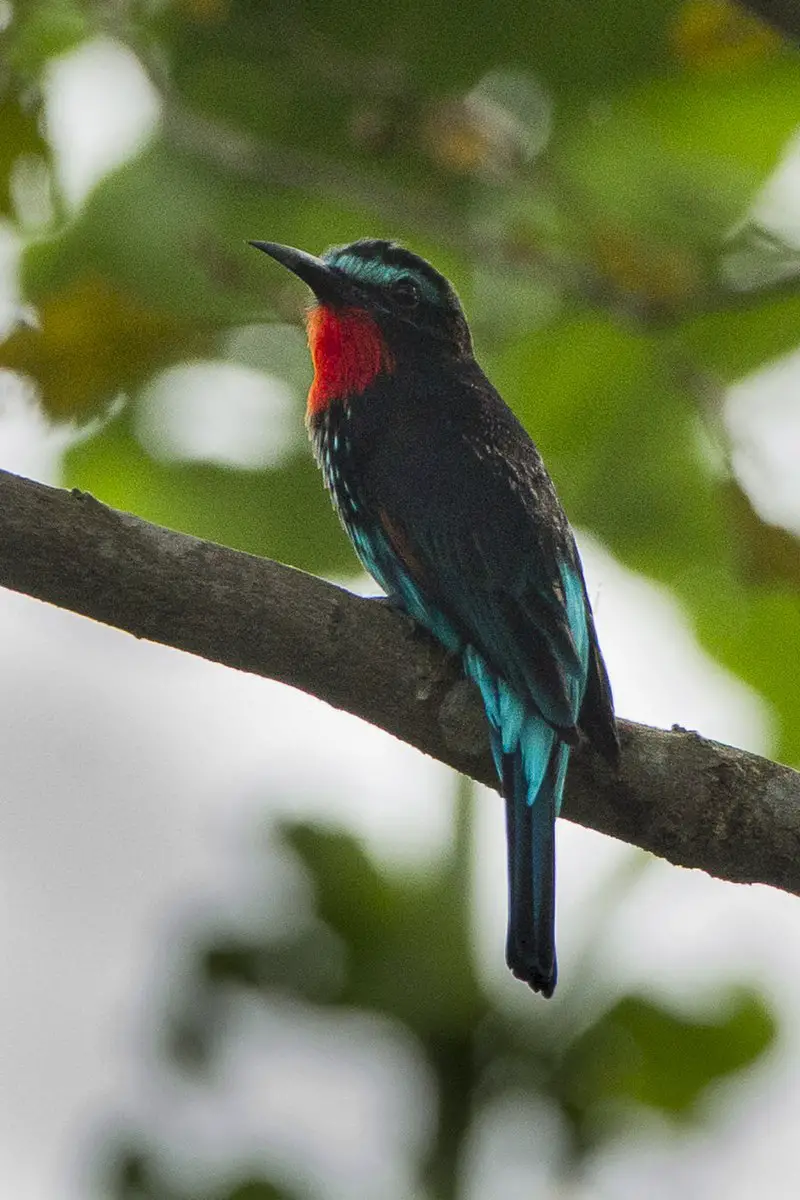
The Black bee-eater is an impressive bird that loves to live in the African tropical rainforest. It has a length of around 20 cm and its predominantly black body features some striking colors such as scarlet chin, throat, blue eyebrow, belly and undertail-coverts.
This beautiful creature also enjoys frequenting secondary woodland at the edges of its natural habitat. Its diet mainly consists of bees which it hunts by flying close to them or perching on branches waiting for prey to pass nearby.
During breeding season they construct their nests inside sandy banks where they lay 2–3 eggs each year while both parents take turns incubating them until they hatch and care for their young ones afterwards.
Although not endangered yet this species still needs our protection so we can all enjoy these incredible birds.
Scientific classification:
| Kingdom | Animalia |
| Phylum | Chordata |
| Class | Aves |
| Order | Coraciiformes |
| Family | Meropidae |
| Genus | Merops |
| Species | M. gularis |
23. White-Spotted Flufftail
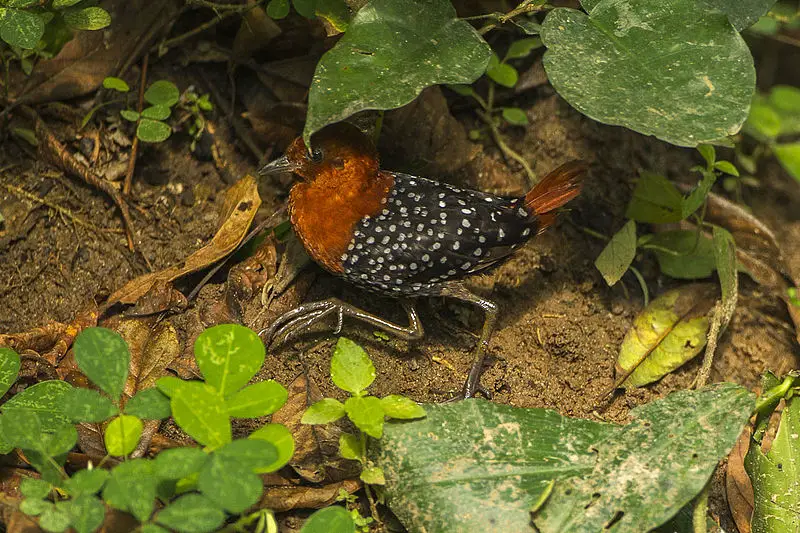
The white-spotted flufftail is a species of bird from the family Sarothruridae. It can be found in tropical rainforest regions across Africa, and its habitat consists of dense vegetation.
The colouration of this small bird is quite striking; it has a grey back, with reddish undertail coverts and black wings that are edged with white spots.
Its head features shades of brown and yellow, while its throat is notably creamy coloured.
These birds feed mainly on insects such as caterpillars but will also consume smaller amounts of fruit when available.
They build nests near water sources or under thick foliage to protect them from predators like hawks or crows which may attack their eggs or young chicks if they get too close by chance.
All in all, the white-spotted flufftail plays an important role in African ecology due to its insectivorous diet habits that help keep pest populations at bay.
Scientific classification:
| Kingdom | Animalia |
| Phylum | Chordata |
| Class | Aves |
| Order | Gruiformes |
| Family | Sarothruridae |
| Genus | Sarothrura |
| Species | S. pulchra |
Also Featured In: Large Birds of Uganda,
24. Water Thick-Knee
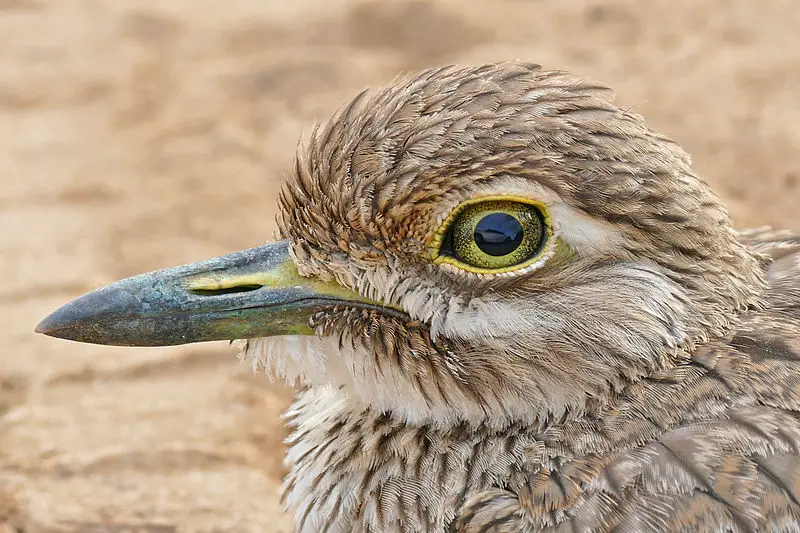
The Water thick-knee is a species of bird belonging to the Burhinidae family. It has a wide distribution in sub-Saharan Africa, where it can be found near waterbodies such as rivers, lakes and wetlands.
Its plumage is dark brown above with white spots on its wings, while below it is mostly greyish or whitish.
The bill is long and straight with yellow legs and feet. During breeding season they are more vocal than usual making loud calls during the night time hours that sound like “keh keh”.
This bird feeds mainly on insects but also takes small reptiles, crustaceans and molluscs from shallow waters when available.
Breeding pairs construct scrapes within grassy areas which they use for nesting sites during the dry season months between July to September depending on location.
Scientific classification:
| Kingdom | Animalia |
| Phylum | Chordata |
| Class | Aves |
| Order | Charadriiformes |
| Family | Burhinidae |
| Genus | Burhinus |
| Species | B. vermiculatus |
25. African Pied Hornbill
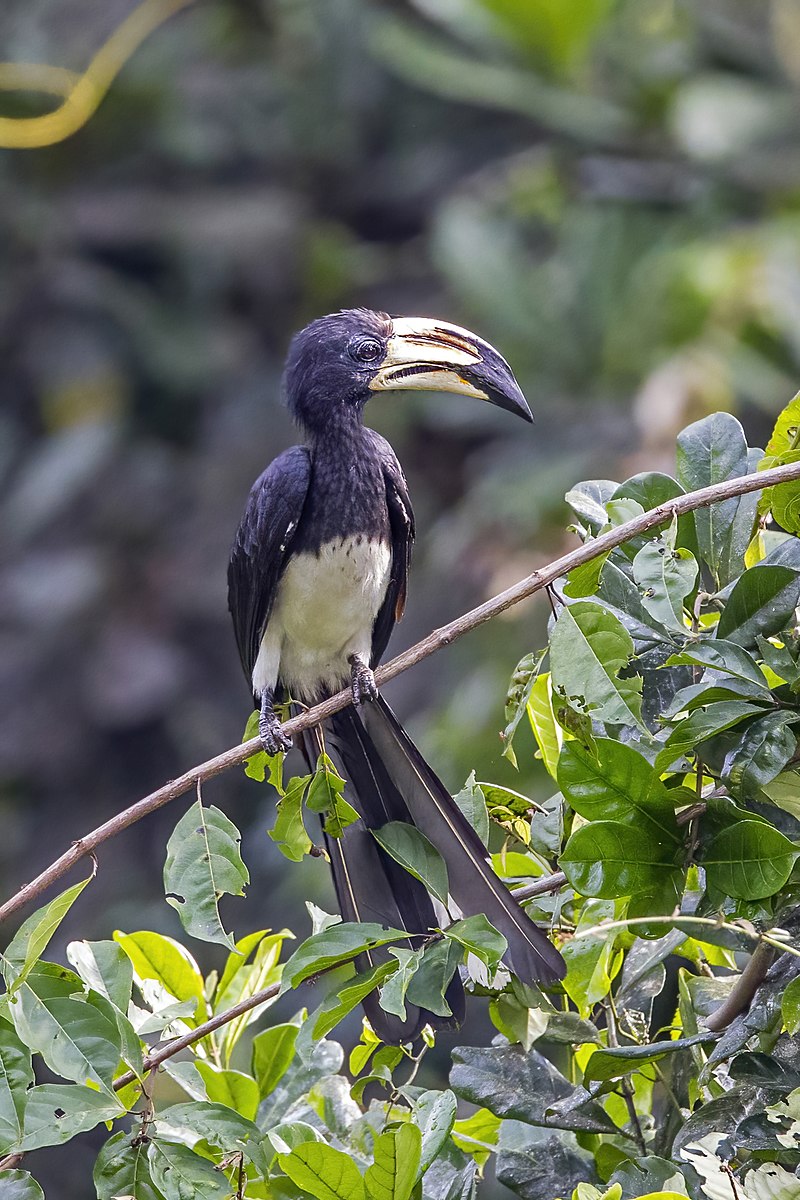
The African pied hornbill is a beautiful bird belonging to the family of tropical near-passerine birds found in the Old World.
It is widely distributed across equatorial Africa, ranging from The Gambia to western Uganda and northern Angola.
This species prefers habitats with plenty of trees for it to nestle in and make its home.
When breeding season arrives, females lay up to four white eggs inside tree holes that are sealed off by the males using mud or other materials as part of their nesting ritual.
These magnificent creatures have distinctive features such as black feathers on their bodies contrasted against bright yellow eyes and strikingly long beaks which they use mainly for eating fruit but also insects too.
They are an important part of African ecosystems and should be protected at all costs so future generations can continue appreciating these majestic birds.
Scientific classification:
| Kingdom | Animalia |
| Phylum | Chordata |
| Class | Aves |
| Order | Bucerotiformes |
| Family | Bucerotidae |
| Genus | Lophoceros |
| Species | L. fasciatus |
26. Little Weaver
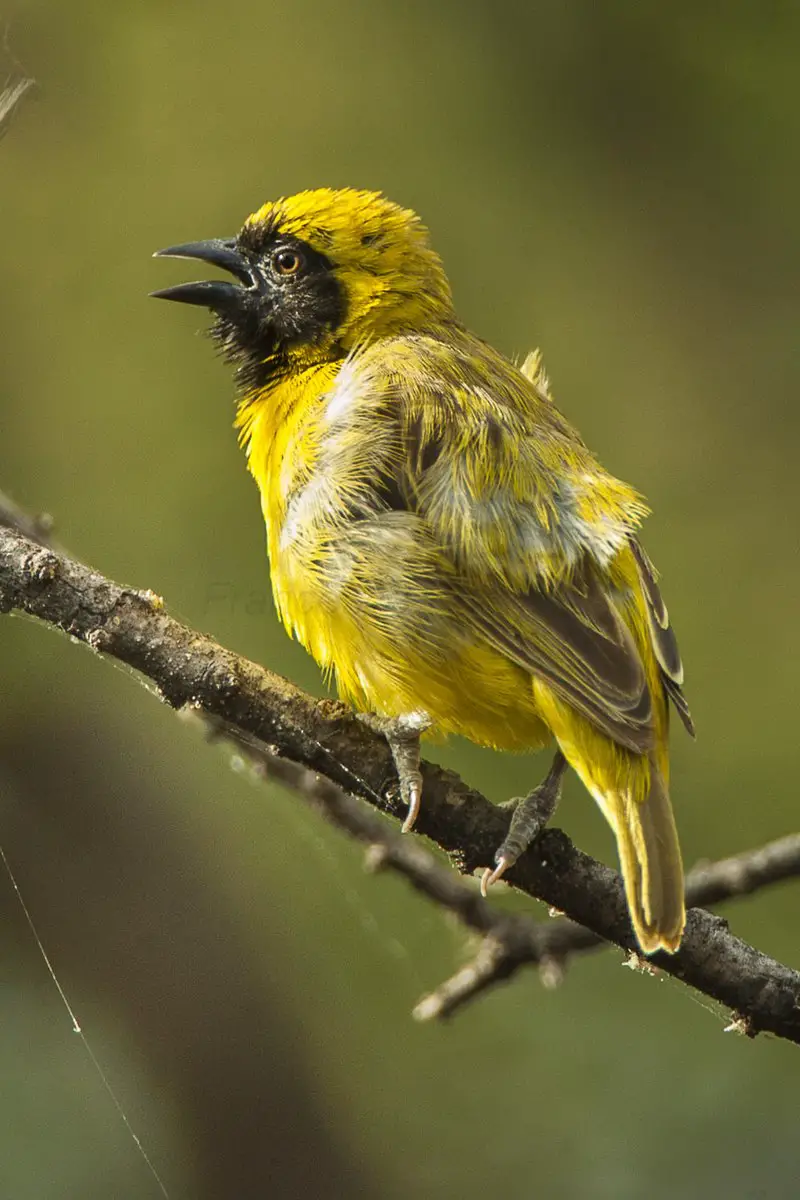
The Little Weaver is a species of bird found in western, central and eastern Africa. It has light brown upperparts with white underparts, chestnut flanks and wings barred with black.
Its head is yellowish-gray with dark streaks throughout its crown and nape area. The bill and legs are pinkish-brown while the eyes are reddish-brown. This species feeds mainly on seeds but will also consume insects if available.
They form monogamous pairs that build their nests out of dry grasses which they weave into intricate structures suspended from trees or other vegetation up to 3 meters off the ground; this gives them protection from predators as well as harsh weather conditions such as rain or heat waves during summer months.
These birds breed seasonally between late April until August depending on food availability in the region it inhabits making them an important part of many African ecosystems.
Scientific classification:
| Kingdom | Animalia |
| Phylum | Chordata |
| Class | Aves |
| Order | Passeriformes |
| Family | Ploceidae |
| Genus | Ploceus |
| Species | P. luteolus |